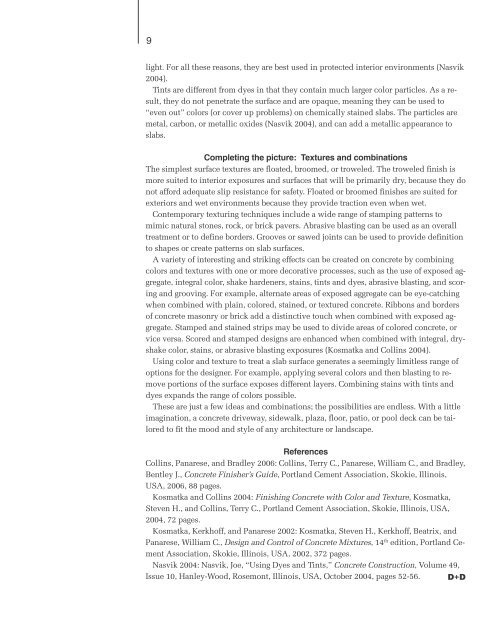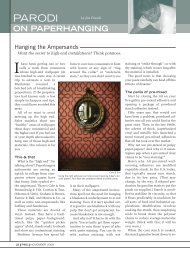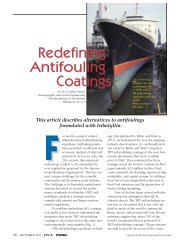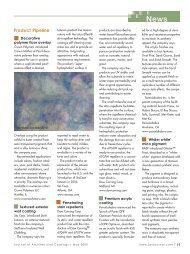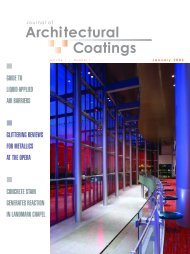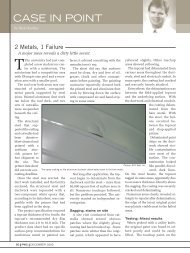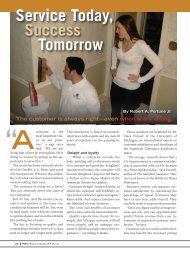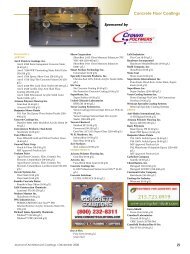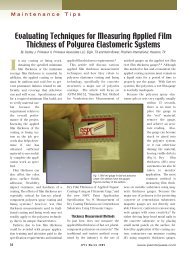Decorative Treatments for Concrete Floors: A ... - PaintSquare
Decorative Treatments for Concrete Floors: A ... - PaintSquare
Decorative Treatments for Concrete Floors: A ... - PaintSquare
Create successful ePaper yourself
Turn your PDF publications into a flip-book with our unique Google optimized e-Paper software.
9light. For all these reasons, they are best used in protected interior environments (Nasvik2004).Tints are different from dyes in that they contain much larger color particles. As a result,they do not penetrate the surface and are opaque, meaning they can be used to“even out” colors (or cover up problems) on chemically stained slabs. The particles aremetal, carbon, or metallic oxides (Nasvik 2004), and can add a metallic appearance toslabs.Completing the picture: Textures and combinationsThe simplest surface textures are floated, broomed, or troweled. The troweled finish ismore suited to interior exposures and surfaces that will be primarily dry, because they donot af<strong>for</strong>d adequate slip resistance <strong>for</strong> safety. Floated or broomed finishes are suited <strong>for</strong>exteriors and wet environments because they provide traction even when wet.Contemporary texturing techniques include a wide range of stamping patterns tomimic natural stones, rock, or brick pavers. Abrasive blasting can be used as an overalltreatment or to define borders. Grooves or sawed joints can be used to provide definitionto shapes or create patterns on slab surfaces.A variety of interesting and striking effects can be created on concrete by combiningcolors and textures with one or more decorative processes, such as the use of exposed aggregate,integral color, shake hardeners, stains, tints and dyes, abrasive blasting, and scoringand grooving. For example, alternate areas of exposed aggregate can be eye-catchingwhen combined with plain, colored, stained, or textured concrete. Ribbons and bordersof concrete masonry or brick add a distinctive touch when combined with exposed aggregate.Stamped and stained strips may be used to divide areas of colored concrete, orvice versa. Scored and stamped designs are enhanced when combined with integral, dryshakecolor, stains, or abrasive blasting exposures (Kosmatka and Collins 2004).Using color and texture to treat a slab surface generates a seemingly limitless range ofoptions <strong>for</strong> the designer. For example, applying several colors and then blasting to removeportions of the surface exposes different layers. Combining stains with tints anddyes expands the range of colors possible.These are just a few ideas and combinations; the possibilities are endless. With a littleimagination, a concrete driveway, sidewalk, plaza, floor, patio, or pool deck can be tailoredto fit the mood and style of any architecture or landscape.ReferencesCollins, Panarese, and Bradley 2006: Collins, Terry C., Panarese, William C., and Bradley,Bentley J., <strong>Concrete</strong> Finisher’s Guide, Portland Cement Association, Skokie, Illinois,USA, 2006, 88 pages.Kosmatka and Collins 2004: Finishing <strong>Concrete</strong> with Color and Texture, Kosmatka,Steven H., and Collins, Terry C., Portland Cement Association, Skokie, Illinois, USA,2004, 72 pages.Kosmatka, Kerkhoff, and Panarese 2002: Kosmatka, Steven H., Kerkhoff, Beatrix, andPanarese, William C., Design and Control of <strong>Concrete</strong> Mixtures, 14 th edition, Portland CementAssociation, Skokie, Illinois, USA, 2002, 372 pages.Nasvik 2004: Nasvik, Joe, “Using Dyes and Tints,” <strong>Concrete</strong> Construction, Volume 49,Issue 10, Hanley-Wood, Rosemont, Illinois, USA, October 2004, pages 52-56. D+D


